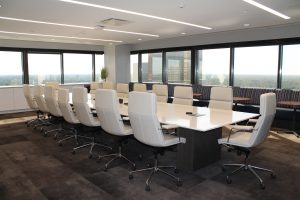Empowering Change: An HR Leader’s View on Advancing Gender Diversity in STEM
By Alex Catana

 Wendy Mackey Jones is a purpose-driven HR leader and Director HR Business Partnering at Vanderlande, where she leads the people strategy across EMEA, LATAM, and Global Operations. With over 20 years of experience spanning corporate, non-profit, and government sectors, Wendy is known for aligning business transformation with people-centred outcomes.
Wendy Mackey Jones is a purpose-driven HR leader and Director HR Business Partnering at Vanderlande, where she leads the people strategy across EMEA, LATAM, and Global Operations. With over 20 years of experience spanning corporate, non-profit, and government sectors, Wendy is known for aligning business transformation with people-centred outcomes.
At Vanderlande, she plays a key role in shaping a high-performing and inclusive culture. Wendy has led large-scale organisational change, improved employee satisfaction, and spearheaded initiatives like the Women + Allies Network and cross-border development programmes. Her strategic focus areas include DEI, leadership development, change management, and workforce planning – all grounded in data-driven decision-making and trust-based collaboration.
Whether mentoring future leaders or redefining people strategies at scale, Wendy brings energy, empathy, and a deep belief in the power of empowered people to create lasting impact.
Introduction & Background:
Can you give us a brief introduction and tell us what your role at Vanderlande is?
My name is Wendy Mackey Jones, and I am the HR Business Partner for our Airports Domain in Vanderlande Industries BV in the region of EMEA, LATAM, and for our Airport Global Operations.
What does the team structure look like across your business unit and the larger organisation?
The Airports domain is Vanderlande’s largest business in terms of FTE – with nearly 4,000 of the 9,500 employees in our company (pre our merger with Siemens Logistics). Organised into regions – North America, EMEA LATAM, APAC and China – we partner with airport customers to deliver and service baggage handling systems and software enabled solutions. We are an engineering, project delivery, and service organisation. EMEA, LATAM and Global Operations represents approximately 2000 employees spread across more than 17 countries.
Diversity Landscape at Vanderlande:
Describe the current state of gender diversity within the organisation?
In Airports EMEA, LATAM and Global Operations, women currently represent 8.5% of our workforce across all levels and all roles. At the senior level, female representation stands at 8.1%. Our goal for the next 5 years is to increase our total representation to 15% and female leadership to 18%.
Are there certain departments where female representation is stronger or weaker? Why?
When we look at female representation across different functions, our service organisation – which primarily involves site-based, shift work – has the lowest percentage of women at 5.9%. This is not uncommon for these types of roles.
We see much stronger representation in other areas, including Project Execution (19.7%), Sales (17.1%), and IT Deployment (16.7%).
If we exclude the service function from the data set, overall female representation in EMEA, LATAM, and Global Operations rises significantly – from 8.5% to 14%.
What challenges do you see in attracting women into these functions?
The biggest challenge we have, which is similar for all STEM organisations, is that the pool of female candidates is relatively very small.
Initiatives and Best Practices:
What initiatives have proven effective in driving gender diversity?
Within Vanderlande, we’re in the early stages of our DEI journey, but momentum is building. Last year, we launched a Women and Allies Network to better understand what women in our organisation need. The top requests were: mentoring, networking, and development.
In response, we introduced our first mentoring program for women across EMEA and LATAM, drawing on best practices from APAC and China. Senior leaders (male and female) joined as mentors, and we matched 27 pairs across five countries, including 11 cross-border connections. The programme focused on development and sponsorship, supported by webinars, tips for effective mentoring, and regular pulse checks to ensure that the programme was effective. Midway, we saw 100% satisfaction, and a final satisfaction rating of 5.14 out of 6.
We also hosted an online event with Catalyst in January 2025, featuring new research and a leadership panel.
Over the past year, we launched 3 new leadership development programmes, each including DEI content, to support key talent from early careers to senior roles.
It’s been a busy and energising year of progress!
Can you tell us more about the outreach to schools and colleges, such as the workshops for schoolgirls and the STEM career fairs?
As part of our People Strategy, we’re building momentum in DEI through outreach. After sharing our goals with the Talent Acquisition team, I was excited to support several outreach initiatives – starting with hosting school girls at our Veghel campus in the Netherlands. The aim was to inspire them and showcase the diverse opportunities at Vanderlande.
We have hosted 2 successful sessions this year, which included campus tours, hands-on projects in our Innovation Centre, and lunch with female team members. We also participated in STEM Career fairs in Amsterdam and London, giving our engineers, commercial leads, and technology colleagues the chance to connect with and motivate future talent to join us.
These outreach efforts are something I deeply believe in – and we’ll continue collaborating across Vanderlande to grow their impact!
The Role of Allyship and Leadership:
When it comes to getting men to be active participants in diversity efforts, how do you foster that engagement at Vanderlande?
In my years with PWN Global (Professional Women’s Network Global), I saw too many conversations about gender equality happening amongst women only. Real change requires everyone’s involvement – not only because it’s right, but because it’s good business. Allyship and leadership role modelling are therefore essential.
That’s why we hosted a senior leadership event on Allyship last summer – we wanted to raise awareness, kick-start conversations and shift perspectives. It was a strong starting point.
Our mentoring program had a majority of male mentors; their personal experience was powerful. Many described eye-opening insights and are now asking when the next round will begin – clear proof of lasting impact.
What would you say to leaders – especially male leaders – about their role in championing diversity
We say, “We need your support, come and join us in making a difference!” That was exactly the message of an event we hosted at the beginning of 2025, with over 140 employees joining in person and online.
Catalyst’s Carlone Pickard opened with a powerful keynote, sharing data and issuing a call to action. She then sat on a panel with one of our female leaders and two male leaders. The message was clear: diversity is essential, and we all share the responsibility – from recruitment and development to awareness and action. These leaders were real examples of role modelling – they see the need, they agree with the benefits, and they accept their role in making the change happen, and more importantly, they’re acting on it!
Storytelling & Visibility:
How important is storytelling in encouraging more women to enter engineering?
Storytelling is powerful, but it has to be the right kind. DEI progress is still too slow globally, and we won’t move the needle with only feel-good messages. Storytelling needs to be realistic, as well as inspiring, and motivating. It should highlight what’s not working and why, without blame – helping people see both the risks of inaction and the benefits of being part of the change.
I’ve been especially inspired by the stories of companies who are continuing to embed DEI into their cultures despite political pushback. In a world where women are accountable for 70-80% of consumer spending, companies need to recognise the impact of their positive storytelling can have on their baseline sale!
Could you share an example of a success story from within Vanderlande?
I’m proud of what we’ve achieved in a short time – especially because the impact is already tangible:
- In our mentoring programme, a young female project manager was nominated by her mentor to be part of a global project; without this sponsorship it is unlikely that her name would have been raised for this opportunity.
- After a leadership programme, a young woman shared her ambitions for the future during a coaching session. Her manager’s manager heard this, and it triggered him to adapt a vacancy to create a pathway into leadership.
- In the Middle East, a colleague and mentor has become a strong DEI advocate. In the last year, he’s recruited 7 (3 internally and 4 via a contractor) women into a historically male-dominated environment and launched a graduate program that will initially focus on females to continue to engage, develop and retain female talent.
These are just a few of our examples of powerful allyship in action – and exactly why I’m so proud of our progress.
Looking Ahead:
What are the next steps for your diversity strategy, especially in engineering and project execution?
We’ll continue to actively engage school- and college-aged girls, connect with talent at recruitment fairs, support internships and graduate programmes, and promote our people with DEI as a core leadership priority. Our goal is to embed diversity, equity, and inclusion as a cultural norm – not a checkbox, but the only way forward.
If you could share one piece of advice with young women considering a career in STEM fields, what would it be?
My advice is actually for parents, care givers, and teachers: ‘take ownership in understanding the purpose and opportunities within STEM organisations. This is where you can have the greatest impact on the future workforce. Encourage your daughters or female students to explore the wide range of skills these industries need – not just in science and engineering, but in problem-solving, communication, creativity, and adaptability. STEM is about innovation, rapid development, and real-world impact. Help expand their beliefs beyond what’s possible – the opportunities are far broader and more exciting than many realise.’
And for companies struggling to improve gender diversity – what’s one practical step they can start with?
Know your numbers, start small, and drive a culture that recognises and believes in the benefits of DEI.
Closing Remarks:
Why is it important to you personally to drive diversity in this industry?
DEI has always been deeply personal to me. I was lucky to grow up with strong role models – my great-aunt in the family business and my father, who inspired my path into the business world. They taught me the value of equality and the benefits that can be gained by embracing difference.
Professionally, I have seen first-hand how diverse teams thrive, combining perspectives to drive better outcomes. As a mum of 3 young men, I care deeply about the world they’re growing up in – where they can be their authentic selves, free from outdated expectations.
I’m energised by young people’s aspirations – and driven to help create an environment where they can achieve them!
What do you hope others will take away from hearing about Vanderlande’s experience?
I hope everyone reading this takes at least one thing away – a reminder, a new perspective, or a small shift in thinking – that sparks action and contributes to a more inclusive, positive future for the next generation.
 If you would like to discuss any of the topics raised in this piece or if you need support with your leadership resourcing strategy, please get in touch with Alex Catana on: alex.catana@beaumontbailey.com.
If you would like to discuss any of the topics raised in this piece or if you need support with your leadership resourcing strategy, please get in touch with Alex Catana on: alex.catana@beaumontbailey.com.




